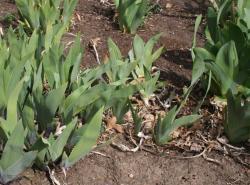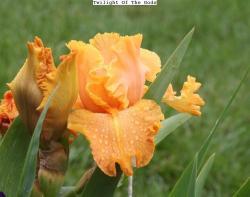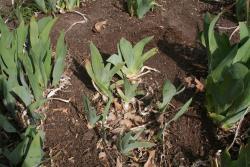Bearded irises grow from rhizomes. These rhizomes are often referred to as “bulbs”, “tubers,” or “roots,” but they are none of those things. They actually are modified stems that grow horizontally just below the ground or along the surface of the ground. Each section of rhizome produces a succession of leaves, a “fan.” When a rhizome reaches maturity, it produces a bloom stalk out of the center of the fan. Once a rhizome has produced a bloom stalk, it will never bloom again, or even grow new leaves or roots. Fortunately, before a rhizome produces a bloom stalk, it typically will produce new “daughter rhizomes” along the sides of the existing “mother rhizome.” Each new rhizome will produce a fan of leaves and, in time, a bloom stalk and daughters of its own.
As a result of this growth pattern, irises usually grow in ever-expanding clumps. That is great, except for two things. First, the clumps eventually get so big that they grow into adjacent clumps. Some varieties are more vigorous than others and they can even overrun their neighbors. Second, the centers of large clumps are often composed entirely of densely packed, spent rhizomes that produce no blooms. Consequently, it is commonly recommended to lift, divide, and replant bearded iris clumps every three or four years. If you have very many clumps, this can become an onerous task. The fact that it is typically done during the heat of summer doesn't make it any more pleasant.
Many people stop to visit with me in my yard during the iris bloom season. An iris bed is simply spectacular in the spring and irresistible even to people who aren't plant fanatics. The most commonly cited reason people give me for their decision not to grow irises themselves is that they don’t want to divide them every few years. It seems like too much work and, if you don’t do it, the beds become so thick and overgrown that the plants stop blooming.

There is an alternative to dividing every three to four years: thinning. All you need is a sharp, heavy-bladed knife or similar tool. I use a Japanese Hori Hori knife (the best garden tool I've ever owned). Simply use the knife to cut and remove the “undesirable” rhizomes from a clump, leaving the “good” ones undisturbed.
Here’s an example of what I do. Here we have clumps of three iris varieties, all planted two years ago. 
The big clump on the left (with the purple-based foliage) is ‘Magnificent Masterpiece’, the smaller clump in the center is ‘Twilight Of The Gods’, and the big clump on the right (with the super thick leaves) is ‘Donaghcloney’. ‘Twilight Of The Gods’ is actually a pretty vigorous plant, judging by the standards for orange irises, but it can’t stand up to either ‘Magnificent Masterpiece’ or ‘Donaghcloney,’ which are rampant growers. You can see that it is already being crowded by its neighbors, just two years after planting.



I simply take the Hori Hori knife and cut through the clumps of ‘Magnificent Masterpiece’ and ‘Donaghcloney’. The blade of the knife is strong enough that I can then use it as a lever to pop the cut rhizomes right out of the ground. In a matter of minutes, ‘Twilight Of The Gods’ has regained some room to grow and the other two have not been harmed in any meaningful way. They have a plentiful supply of mature rhizomes and will still put on a spectacular show when the bloom season starts here in a few weeks.

I also use this technique to remove spent rhizomes from the center of clumps so the plants have an opportunity to grow inward rather than just continually expanding outward. Sometimes I don't do anything more than remove small, weak-looking rhizomes so that the bigger and healthier ones will have more space. One note: I immediately fill the holes left behind by the removal of the rhizomes with compost, thereby enriching the soil a bit. We rarely have problems with rot here, though. If you live in a wetter environment or have richer soils, you might want to let the cuts heal over for a few days before filling the holes and/or use another type of top dressing instead of compost.
Thinning is a simple and quick method of correcting overcrowding in iris beds. One of the great things about it is that you can do it whenever you have few minutes to spare in the garden and you can do as little or as much at any given time as you wish, in contrast to dividing, which normally requires re-working an entire bed at once. If you are diligent about thinning, you may never have to divide your irises again. Even if you are like me and not so diligent, you can still use thinning to extend the time between dividing to six to ten years rather than three to four.
| Thread Title | Last Reply | Replies |
|---|---|---|
| Really helpful article - thank you! by cliftoncat | Feb 19, 2020 1:40 PM | 1 |
| Puzzled? by millerjoanni | Feb 3, 2017 3:11 PM | 1 |
| Untitled by Rebekah | Oct 26, 2016 12:14 AM | 0 |
| Useful article! by janwax | Oct 15, 2016 10:11 PM | 0 |
| I learned something by crittergarden | Apr 6, 2014 2:19 PM | 2 |
| 1,000 Thanks! by Bonehead | Dec 7, 2013 9:24 PM | 23 |
| Timing? by stilldew | May 17, 2013 5:02 AM | 0 |